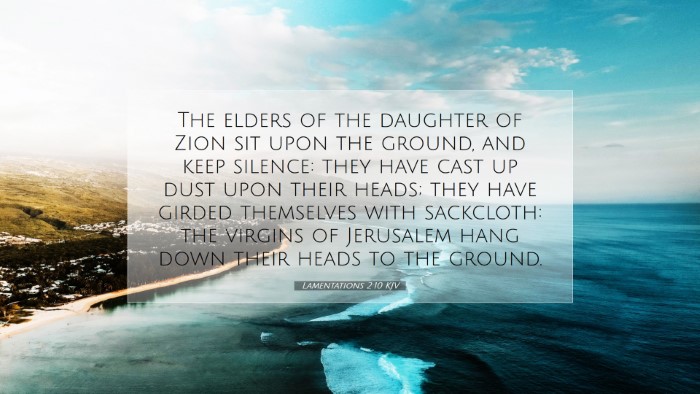Lamentations 2:10 Commentary
Verse: “The elders of the daughter of Zion sit upon the ground, and keep silence: they have cast up dust upon their heads; they have girded themselves with sackcloth: the virgins of Jerusalem hang down their heads to the ground.”
Introduction
The book of Lamentations is a poignant expression of grief and mourning over the destruction of Jerusalem and the temple. The second chapter, particularly verse 10, poignantly captures the sorrow and lament of a nation in despair. This commentary merges insights from various public domain theologians, examining the depth of emotional and spiritual turmoil reflected in this verse.
Contextual Background
Lamentations is traditionally attributed to the prophet Jeremiah, who mourns the devastation resulting from the Babylonian siege. This chapter highlights the profound grief of the city's leaders and its inhabitants. As we explore verse 10, we must understand it within the wider context of national catastrophe and divine judgment.
Exegesis of Verse 10
The verse begins with the observation of the elders of Zion. Their actions symbolize a deep psychological response to calamity.
- The Elders: The elders represent the leadership and wisdom of the community. Their silence indicates a profound sense of loss and disbelief. As Matthew Henry notes, “their silence spoke louder than words, indicating their hopelessness.”
- Silence and Mourning: The act of sitting upon the ground signifies humility and submission to God’s judgment. Albert Barnes remarks, “it was customary in mourning for one to sit on the ground, denoting despair.”
- Dust and Sacrifice: The casting up of dust is a biblical symbol of mourning and penitence. Adam Clarke explains, “dust is a symbol of human mortality, depicting the fragility of life and the weight of sin.” This act portrays the elders' acknowledgment of their and the nation’s failures.
- Sackcloth: Wearing sackcloth is reiterative of mourning and penitence, emphasizing the severity of their situation. Henry further emphasizes that “sackcloth was the clothing of grief, indicating their inner torment.”
- The Virgins of Jerusalem: This phrase highlights the despair of young women, emblematic of Israel's purity and hope. Their bowed heads reflect the communal spirit of sorrow and hope lost. Clarke asserts that their mourning “represents the collective grief of a nation robbed of joy and promise.”
These actions collectively illustrate a deep social and spiritual crisis, showcasing a community grappling with the consequences of their disobedience and the resultant calamity.
Theological Insights
Beyond the immediate context, this verse serves as a mirror reflecting themes of loss, repentance, and the need for communal mourning.
- The Weight of Leadership: The elders’ grief reminds us of the burden borne by leaders during times of national crisis. Their silence denotes a call for introspection and recognition of responsibility for the community's spiritual state.
- Corporate Mourning: Lamentations emphasizes that lament is a communal activity. In times of grief, individual sorrow becomes collective, leading to a unified heartache that reinforces community identity in the face of anguish.
- Divine Judgment: The actions of the elders and virgins underscore a recognition of God’s hand in their suffering. Barnas indicates, “their mourning serves as a backdrop for understanding God’s displeasure, compelling them to seek reconciliation through genuine repentance.”
- Hope in Despair: While this verse encapsulates profound sorrow, it ultimately points to the necessity for hope. Within the anguish of mourning lies the seed of restoration through God’s mercy, a recurring theme in the overarching narrative of Scripture.
Application for Today
For pastors, theologians, and students of Scripture, Lamentations 2:10 serves as a powerful reminder of the emotional weight of sin and the necessity of communal lament. In an age marked by individualism, this verse prompts a return to collective responsibility and shared mourning.
- Encouraging Corporate Grief: In modern ministry, facilitating spaces for corporate lament can lead to healing and restoration, mirroring the ancient practices of communal mourning.
- Recognizing Spiritual Leadership: Leaders must recognize their role in guiding their congregations through times of crisis, emphasizing that silence and reflection are sometimes the most profound responses to tragedy.
- Awareness of God’s Judgment: Understanding the consequences of sin is crucial. Churches are called to educate their communities about the realities of divine judgment while highlighting the availability of grace and reconciliation.
- Restoration and Hope: Ultimately, amidst the echoes of despair, we must direct our attention to God’s promise of restoration. Just as lament leads to hope in Scripture, the church must proclaim the transformative power of God’s grace.
Conclusion
Lamentations 2:10 resonates with the timeless themes of sorrow, repentance, and hope. This verse not only encapsulates the anguish of a broken nation but also serves as a testament to the depth of human emotion when confronted with divine judgment. Through the lens of scholarship and theological reflection, we find rich insights that empower us as shepherds and scholars to engage deeply with the challenges of our communities, always pointing towards the hope found in Christ.


